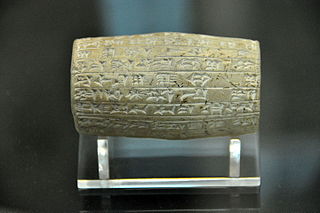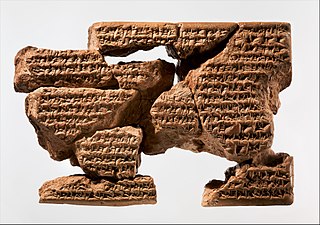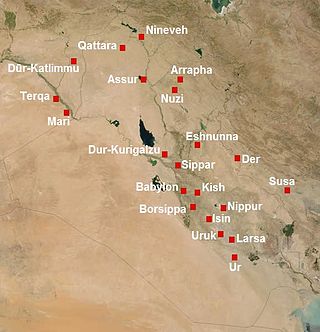Related Research Articles

Chaldea was a small country that existed between the late 10th or early 9th and mid-6th centuries BC, after which the country and its people were absorbed and assimilated into the indigenous population of Babylonia. Semitic-speaking, it was located in the marshy land of the far southeastern corner of Mesopotamia and briefly came to rule Babylon. The Hebrew Bible uses the term כשדים (Kaśdim) and this is translated as Chaldaeans in the Greek Old Testament, although there is some dispute as to whether Kasdim in fact means Chaldean or refers to the south Mesopotamian Kaldu.

The 7th century BC began the first day of 700 BC and ended the last day of 601 BC.
This article concerns the period 619 BC – 610 BC.

Nabopolassar was the founder and first king of the Neo-Babylonian Empire, ruling from his coronation as king of Babylon in 626 BC to his death in 605 BC. Though initially only aimed at restoring and securing the independence of Babylonia, Nabopolassar's uprising against the Neo-Assyrian Empire, which had ruled Babylonia for more than a century, eventually led to the complete destruction of the Assyrian Empire and the rise of the Neo-Babylonian Empire in its place.
The year 627 BC was a year of the pre-Julian Roman calendar. In the Roman Empire, it was known as year 127 Ab urbe condita. The denomination 627 BC for this year has been used since the early medieval period, when the Anno Domini calendar era became the prevalent method in Europe for naming years.

Sîn-šar-iškun was the penultimate king of Assyria, reigning from the death of his brother and predecessor Aššur-etil-ilāni in 627 BC to his own death at the Fall of Nineveh in 612 BC.
Aššur-etil-ilāni, also spelled Ashur-etel-ilani and Ashuretillilani, was the king of the Neo-Assyrian Empire from the death of his father Ashurbanipal in 631 BC to his own death in 627 BC. Aššur-etil-ilāni is an obscure figure with a brief reign from which few inscriptions survive. Because of this lack of sources, very little concrete information about the king and his reign can be deduced.

Sîn-šumu-līšir or Sîn-šumu-lēšir, also spelled Sin-shum-lishir, was a usurper king in the Neo-Assyrian Empire, ruling some cities in northern Babylonia for three months in 626 BC during a revolt against the rule of the king Sîn-šar-iškun. He was the only eunuch to ever claim the throne of Assyria.
Kandalanu was a vassal king of Babylon under the Neo-Assyrian kings Ashurbanipal and Ashur-etil-ilani, ruling from his appointment by Ashurbanipal in 647 BC to his own death in 627 BC.

The Neo-Assyrian Empire was the fourth and penultimate stage of ancient Assyrian history. Beginning with the accession of Adad-nirari II in 911 BC, the Neo-Assyrian Empire grew to dominate the ancient Near East and parts of Caucasus, North Africa and East Mediterranean throughout much of the 9th to 7th centuries BC, becoming the largest empire in history up to that point. Because of its geopolitical dominance and ideology based in world domination, the Neo-Assyrian Empire is by many researchers regarded to have been the first world empire in history. It influenced other empires of the ancient world culturally, administratively, and militarily, including the Babylonians, the Achaemenids, and the Seleucids. At its height, the empire was the strongest military power in the world and ruled over all of Mesopotamia, the Levant and Egypt, as well as parts of Anatolia, Arabia and modern-day Iran and Armenia.

The Revolt of Babylon in 626 BC refers to the revolt of the general Nabopolassar and his war of independence until he successfully consolidated control of Babylonia in 620 BC, defeating the Neo-Assyrian Empire which had ruled Babylonia for more than a century. The revolt saw the formation of the Neo-Babylonian Empire and was one of the key factors contributing to the fall of Assyria; twenty years after the revolt had begun, Nabopolassar's army and that of his ally, Cyaxares of the Medes, had destroyed the Neo-Assyrian Empire.
Duke Xiang of Jin was from 627 to 621 BC the ruler of the State of Jin, a major power during the Spring and Autumn period of ancient China. His ancestral name was Ji, given name Huan, and Duke Xiang was his posthumous title. He succeeded his father Duke Wen of Jin, who was the Hegemon of China.
Aššur-uballiṭ II, also spelled Assur-uballit II and Ashuruballit II, was the final ruler of Assyria, ruling from his predecessor Sîn-šar-iškun's death at the Fall of Nineveh in 612 BC to his own defeat at Harran in 609 BC. He was possibly the son of Sîn-šar-iškun and likely the same person as a crown prince mentioned in inscriptions at the Assyrian capital of Nineveh in 626 and 623 BC.

The Medo-Babylonian conquest of the Assyrian Empire was the last war fought by the Neo-Assyrian Empire, between 626 and 609 BC. Succeeding his brother Ashur-etil-ilani, the new king of Assyria, Sinsharishkun, immediately faced the revolt of one of his brother's chief generals, Sin-shumu-lishir, who attempted to usurp the throne for himself. Though this threat was dealt with relatively quickly, the instability caused by the brief civil war may have made it possible for another official or general, Nabopolassar, to rise up and seize power in Babylonia. Sinsharishkun's inability to defeat Nabopolassar, despite repeated attempts over the course of several years, allowed Nabopolassar to consolidate power and form the Neo-Babylonian Empire, restoring Babylonian independence after more than a century of Assyrian rule. The Neo-Babylonian Empire, and the newly-formed Median Empire under King Cyaxares, then invaded the Assyrian heartland. In 614 BC, the Medes captured and sacked Assur, the ceremonial and religious heart of the Assyrian Empire, and in 612 BC, their combined armies attacked and razed Nineveh, the Assyrian capital. Sinsharishkun's fate is unknown but it is assumed that he died in the defense of his capital. He was succeeded as king only by Ashur-uballit II, possibly his son, who rallied what remained of the Assyrian army at the city of Harran and, bolstered by an alliance with Egypt, ruled for three years, in a last attempt to resist the Medo-Babylonian invasion of his realm.
After the death of Assurbanipal in 627 BC, the Neo-Assyrian empire entered a period of instability caused by fighting between Sin-shar-ishkun and his brother Assur-etil-ilani. In 626 BC, Nabopolassar, the Babylonian ruler revolted against the Assyrians. After a few years of war, the Babylonians expelled the Assyrian forces from their territory. However, Nabopolassar could not bring the fight to the heartland of the Assyrian empire. The situation changed drastically in 616 BC, when the Medes attacked the Assyrian empire. The fall of Tarbiṣu occurred when the Median army, led by Cyaxares, attacked and conquered the city. In the aftermath, the Medes went further and decisively defeated the Assyrians at the battle of Assur.
The Kings of Byblos were the rulers of Byblos, the ancient Phoenician city in what is now Lebanon.
Grant Frame is a Canadian-American Assyriologist, Professor Emeritus of the University of Pennsylvania, and Curator Emeritus of the Babylonian Section of the University of Pennsylvania Museum of Archaeology and Anthropology. He is an expert on Akkadian language and literature and on the history and culture of ancient Mesopotamia in the first millennium BCE, in particular the Neo-Assyrian and Neo-Babylonian periods. Since 2008, he has served as Director and Editor-in-Chief of The Royal Inscriptions of the Neo-Assyrian Period (RINAP), an international research project funded by the U.S. government's National Endowment for the Humanities and other granting agencies, to translate the royal inscriptions of the rulers of Assyria from 744 to 609 BC. The RINAP project marks the continuation of the Royal Inscriptions of Mesopotamia (RIM) project, which Frame's teacher and mentor, Albert Kirk Grayson, founded at the University of Toronto in 1978 and led until his retirement with support from the Social Sciences and Humanities Research Council of Canada.
References
- ↑ Grote, George (2013-05-13). Caspari, M.O.B; Mitchell, J.M (eds.). A History of Greece. Routledge. doi:10.4324/9780203425848. ISBN 978-1-134-59378-1.